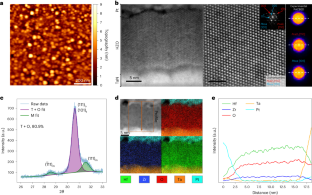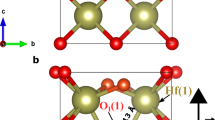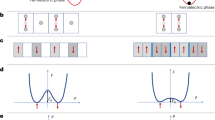Abstract
Ferroelectricity in binary oxides including hafnia and zirconia has riveted the attention of the scientific community due to the highly unconventional physical mechanisms and the potential for the integration of these materials into semiconductor workflows. Over the last decade, it has been argued that behaviours such as wake-up phenomena and an extreme sensitivity to electrode and processing conditions suggest that ferroelectricity in these materials is strongly influenced by other factors, including electrochemical boundary conditions and strain. Here we argue that the properties of these materials emerge due to the interplay between the bulk competition between ferroelectric and structural instabilities, similar to that in classical antiferroelectrics, coupled with non-local screening mediated by the finite density of states at surfaces and internal interfaces. Via the decoupling of electrochemical and electrostatic controls, realized via environmental and ultra-high vacuum piezoresponse force microscopy, we show that these materials demonstrate a rich spectrum of ferroic behaviours including partial-pressure-induced and temperature-induced transitions between ferroelectric and antiferroelectric behaviours. These behaviours are consistent with an antiferroionic model and suggest strategies for hafnia-based device optimization.
This is a preview of subscription content, access via your institution
Access options
Access Nature and 54 other Nature Portfolio journals
Get Nature+, our best-value online-access subscription
$29.99 / 30 days
cancel any time
Subscribe to this journal
Receive 12 print issues and online access
$259.00 per year
only $21.58 per issue
Buy this article
- Purchase on Springer Link
- Instant access to full article PDF
Prices may be subject to local taxes which are calculated during checkout





Similar content being viewed by others
Data availability
The data that support the findings of this study are available from the corresponding authors upon request. Data supporting the theoretical results were visualized in Mathematica 12.2 (https://www.wolfram.com/mathematica) and can be found at the Notebook Archive (https://github.com/SergeiVKalinin/SergeiVKalinin-Hafnia_NatureMaterials2023/blob/main/arxiv_org_abs_HZO-2023_ANM.nb). Source data are provided with this paper.
Code availability
Detailed information related to the codes used in this manuscript is available in the Supplementary Information files or from the corresponding authors upon request.
References
Boscke, T. S. et al. Phase transitions in ferroelectric silicon doped hafnium oxide. Appl. Phys. Lett. 99, 112904 (2011).
Muller, J. et al. Ferroelectric Zr0.5Hf0.5O2 thin films for nonvolatile memory applications. Appl. Phys. Lett. 99, 112901 (2011).
Auciello, O., Scott, J. F. & Ramesh, R. The physics of ferroelectric memories. Phys. Today 51, 22–27 (1998).
Crawford, J. C. Ferroelectric-piezoelectric random access memory. IEEE Trans. Electron Dev. 18, 951–958 (1971).
Tsymbal, E. Y. & Kohlstedt, H. Tunneling across a ferroelectric. Science 313, 181–183 (2006).
Zhuravlev, M. Y., Sabirianov, R. F., Jaswal, S. S. & Tsymbal, E. Y. Giant electroresistance in ferroelectric tunnel junctions. Phys. Rev. Lett. 94, 246802 (2005).
Ito, K. & Tsuchiya, H. Memory modes of ferroelectric field-effect transistors. Solid State Electron. 20, 529–537 (1977).
Rost, T. A., Lin, H. & Rabson, T. A. Ferroelectric switching of a field-effect transistor with a lithium niobate gate insulator. Appl. Phys. Lett. 59, 3654–3656 (1991).
Gajek, M. et al. Tunnel junctions with multiferroic barriers. Nat. Mater. 6, 296–302 (2007).
Hur, N. et al. Electric polarization reversal and memory in a multiferroic material induced by magnetic fields. Nature 429, 392–395 (2004).
Ferri, K. et al. Ferroelectrics everywhere: ferroelectricity in magnesium substituted zinc oxide thin films. J. Appl. Phys. 130, 044101 (2021).
Zhu, W. L. et al. Wake-up in Al1–xBxN ferroelectric films. Adv. Electron Mater. 8, 2100931 (2021).
Hayden, J. et al. Ferroelectricity in boron-substituted aluminum nitride thin films. Phys. Rev. Mater. 5, 044412 (2021).
Yasuoka, S. et al. Effects of deposition conditions on the ferroelectric properties of (Al1–xScx)N thin films. J. Appl. Phys. 128, 114103 (2020).
Akiyama, M. et al. Enhancement of piezoelectric response in scandium aluminum nitride alloy thin films prepared by dual reactive cosputtering. Adv. Mater. 21, 593–596 (2009).
Fichtner, S., Wolff, N., Lofink, F., Kienle, L. & Wagner, B. AlScN: a III-V semiconductor based ferroelectric. J. Appl. Phys. 125, 114103 (2019).
Mikolajick, T., Schroeder, U. & Park, M. H. Special topic on ferroelectricity in hafnium oxide: materials and devices. Appl Phys. Lett. 118, 180402 (2021).
Materlik, R., Kunneth, C. & Kersch, A. The origin of ferroelectricity in Hf1–xZrxO2: a computational investigation and a surface energy model. J. Appl. Phys. 117, 134109 (2015).
Huan, T. D., Sharma, V., Rossetti, G. A. & Ramprasad, R. Pathways towards ferroelectricity in hafnia. Phys. Rev. B 90, 064111 (2014).
Reyes-Lillo, S. E., Garrity, K. F. & Rabe, K. M. Antiferroelectricity in thin-film ZrO2 from first principles. Phys. Rev. B 90, 140103 (2014).
Schenk, T. et al. Complex internal bias fields in ferroelectric hafnium oxide. ACS Appl. Mater. Interfaces 7, 20224–20233 (2015).
Hoffmann, M. et al. Stabilizing the ferroelectric phase in doped hafnium oxide. J. Appl. Phys. 118, 072006 (2015).
Zhou, D. Y. et al. Wake-up effects in Si-doped hafnium oxide ferroelectric thin films. Appl. Phys. Lett. 103, 192904 (2013).
Siannas, N. et al. Metastable ferroelectricity driven by depolarization fields in ultrathin Hf0.5Zr0.5O2. Commun. Phys. 5, 178 (2022).
Nukala, P. et al. Reversible oxygen migration and phase transitions in hafnia-based ferroelectric devices. Science 372, 630–635 (2021).
Batra, R., Huan, T. D., Jones, J. L., Rossetti, G. & Ramprasad, R. Factors favoring ferroelectricity in hafnia: a first-principles computational study. J. Phys. Chem. C 121, 4139–4145 (2017).
Martin, D. et al. Ferroelectricity in Si-doped HfO2 revealed: a binary lead-free ferroelectric. Adv. Mater. 26, 8198–8202 (2014).
Zhou, S., Zhang, J. & Rappe, A. M. Strain-induced antipolar phase in hafnia stabilizes robust thin-film ferroelectricity. Sci. Adv. 8, eadd5953 (2022).
Hyuk Park, M. et al. Evolution of phases and ferroelectric properties of thin Hf0.5Zr0.5O2 films according to the thickness and annealing temperature. Appl. Phys. Lett. 102, 242905 (2013).
Ihlefeld, J. F., Jaszewski, S. T. & Fields, S. S. A perspective on ferroelectricity in hafnium oxide: mechanisms and considerations regarding its stability and performance. Appl. Phys. Lett. 121, 240502 (2022).
Kim, H. J. et al. Grain size engineering for ferroelectric Hf0.5Zr0.5O2 films by an insertion of Al2O3 interlayer. Appl. Phys. Lett. 105, 192903 (2014).
Garvie, R. C. The occurrence of metastable tetragonal zirconia as a crystallite size effect. J. Phys. Chem. 69, 1238–1243 (1965).
Materlik, R., Künneth, C. & Kersch, A. The origin of ferroelectricity in Hf1−xZrxO2: a computational investigation and a surface energy model. J. Appl. Phys. 117, 134109 (2015).
Cheema, S. S. et al. Emergent ferroelectricity in subnanometer binary oxide films on silicon. Science 376, 648–652 (2022).
Lu, H. et al. Mechanical writing of ferroelectric polarization. Science 336, 59–61 (2012).
Vasudevan, R. K., Balke, N., Maksymovych, P., Jesse, S. & Kalinin, S. V. Ferroelectric or non-ferroelectric: why so many materials exhibit ‘ferroelectricity’ on the nanoscale. Appl. Phys. Rev. 4, 021302 (2017).
Fong, D. D. et al. Stabilization of monodomain polarization in ultrathin PbTiO3 films. Phys. Rev. Lett. 96, 127601 (2006).
Wang, R. V. et al. Reversible chemical switching of a ferroelectric film. Phys. Rev. Lett. 102, 047601 (2009).
Yang, S. M. et al. Mixed electrochemical–ferroelectric states in nanoscale ferroelectrics. Nat. Phys. 13, 812–818 (2017).
Morozovska, A. N., Eliseev, E. A., Morozovsky, N. V. & Kalinin, S. V. Ferroionic states in ferroelectric thin films. Phys. Rev. B 95, 195413 (2017).
Fields, S. S. et al. Origin of ferroelectric phase stabilization via the clamping effect in ferroelectric hafnium zirconium oxide thin films. Adv. Electron. Mater. 8, 2200601 (2022).
Cheng, Y. et al. Reversible transition between the polar and antipolar phases and its implications for wake-up and fatigue in HfO2-based ferroelectric thin film. Nat. Commun. 13, 645 (2022).
Jesse, S. et al. Resolution theory, and static and frequency-dependent cross-talk in piezoresponse force microscopy. Nanotechnology 21, 405703 (2010).
Huey, B. D. et al. The importance of distributed loading and cantilever angle in piezo-force microscopy. J. Electroceram. 13, 287–291 (2004).
Jesse, S., Baddorf, A. P. & Kalinin, S. V. Dynamic behaviour in piezoresponse force microscopy. Nanotechnology 17, 1615–1628 (2006).
Jesse, S., Lee, H. N. & Kalinin, S. V. Quantitative mapping of switching behavior in piezoresponse force microscopy. Rev. Sci. Instrum. 77, 073702 (2006).
Kelley, K. P. et al. Oxygen vacancy injection as a pathway to enhancing electromechanical response in ferroelectrics. Adv. Mater. 34, 2106426 (2022).
Spasojevic, I., Verdaguer, A., Catalan, G. & Domingo, N. Effect of humidity on the writing speed and domain wall dynamics of ferroelectric domains. Adv. Electron. Mater. 8, 2100650 (2022).
Lomenzo, P. D., Richter, C., Mikolajick, T. & Schroeder, U. Depolarization as driving force in antiferroelectric hafnia and ferroelectric wake-up. ACS Appl. Electron. Mater. 2, 1583–1595 (2020).
Morozovska, A. N., Eliseev, E. A., Biswas, A., Morozovsky, N. V. & Kalinin, S. V. Effect of surface ionic screening on polarization reversal and phase diagrams in thin antiferroelectric films for information and energy storage. Phys. Rev. Appl. 16, 044053 (2021).
Doria, S. et al. Nanoscale mapping of oxygen vacancy kinetics in nanocrystalline samarium doped ceria thin films. Appl. Phys. Lett. 103, 171605 (2013).
Kumar, A. et al. Variable temperature electrochemical strain microscopy of Sm-doped ceria. Nanotechnology 24, 145401 (2013).
Acknowledgements
This effort (K.P.K., Y.L., S.S.F., S.T.J., T.M., J.F.I., S.C., E.C.D. and S.V.K.) was supported as part of the Center for 3D Ferroelectric Microelectronics (3DFeM), an Energy Frontier Research Center funded by the US Department of Energy, Office of Science, Basic Energy Sciences under award number DE-SC0021118. The scanning probe microscopy research was performed and partially supported at Oak Ridge National Laboratory’s Center for Nanophase Materials Sciences, a US Department of Energy, Office of Science User Facility. S.T.J. acknowledges support from the US National Science Foundation’s Graduate Research Fellowship Program via grant number DGE-1842490. A.N.M. received funding from the National Academy of Sciences of Ukraine (grant N 4.8/23-II, ‘Innovative materials and systems with magnetic and/or electrodipole ordering for the needs of using spintronics and nanoelectronics in strategically important issues of new technology’, fund 1230) and was also supported by the European Union’s Horizon 2020 research and innovation programme under the Marie Skłodowska-Curie grant agreement no. 778070. Some authors (S.C. and E.C.D.) acknowledge the use of the Materials Characterization Facility at Carnegie Mellon University, supported by MCF-677785.
Author information
Authors and Affiliations
Contributions
K.P.K. performed and conceived experiments; A.N.M. and E.A.E. performed theoretical calculations; Y.L. performed ambient PFM measurements; S.T.J., S.S.F., T.M. and J.F.I. grew samples and performed bulk characterization; S.C. and E.C.D. performed STEM and analysis; and K.P.K. and S.V.K conceived the project. All authors contributed to discussions and the final manuscript.
Corresponding authors
Ethics declarations
Competing interests
The authors declare no competing interests.
Peer review
Peer review information
Nature Materials thanks Thomas Mikolajick, Bo Wang and the other, anonymous, reviewer(s) for their contribution to the peer review of this work.
Additional information
Publisher’s note Springer Nature remains neutral with regard to jurisdictional claims in published maps and institutional affiliations.
Supplementary information
Supplementary Information
Supplementary Figs. 1–16, Tables 1–3, Discussion and References 1–20.
Source data
Source Data Fig. 1
Raw data for Fig. 1 (all panels).
Source Data Fig. 2
Raw data for Fig. 2 (all panels).
Source Data Fig. 3
Raw data for Fig. 3 (all panels).
Source Data Fig. 5
Raw data for Fig. 5 (all panels).
Rights and permissions
Springer Nature or its licensor (e.g. a society or other partner) holds exclusive rights to this article under a publishing agreement with the author(s) or other rightsholder(s); author self-archiving of the accepted manuscript version of this article is solely governed by the terms of such publishing agreement and applicable law.
About this article
Cite this article
Kelley, K.P., Morozovska, A.N., Eliseev, E.A. et al. Ferroelectricity in hafnia controlled via surface electrochemical state. Nat. Mater. 22, 1144–1151 (2023). https://doi.org/10.1038/s41563-023-01619-9
Received:
Accepted:
Published:
Issue Date:
DOI: https://doi.org/10.1038/s41563-023-01619-9
This article is cited by
-
Electrically induced cancellation and inversion of piezoelectricity in ferroelectric Hf0.5Zr0.5O2
Nature Communications (2024)
-
Ferroelastically protected reversible orthorhombic to monoclinic-like phase transition in ZrO2 nanocrystals
Nature Materials (2024)
-
Ferroelectric hafnia surface in action
Nature Materials (2023)



